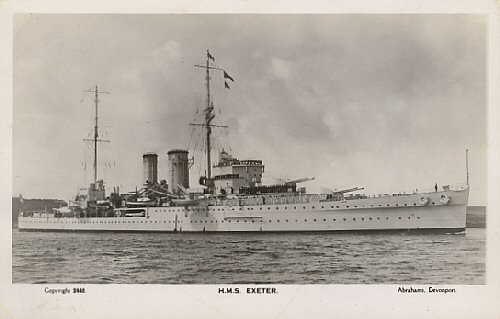
Sunk at the Battle of the Java Sea 28 February 1942
The fourth and best known of the Exeters, HMS Exeter, was a County-class heavy cruiser of the York subclass that served in World War II. She was laid down on 1 August 1928 at the Devonport Dockyard, Plymouth, Devon. She was launched on 18 July 1929 and completed on 27 July 1931.
At the outbreak of the Second World War, she formed part of the South American Division with Cumberland. Together with the light cruisers Ajax and HMS Achilles she engaged the German pocket battleship Admiral Graf Spee in the Battle of the River Plate on 13 December 1939, which action resulted in the scuttling of the Admiral Graf Spee several days later. Severely damaged in the battle, Exeter made for Port Stanley in the Falkland Islands for emergency repairs which took until January 1940, then returned to Devonport for full repairs between February 1940 and March 1941.
On returning to the fleet in 1941, she was engaged on escort duty for Atlantic convoys, including the escort of convoy WS-8B to the Middle East during the Bismarck episode. After this, she went on to the Far East.
On the entry of Japan into the war she formed part of the Allied Striking Force intended to defend the Dutch East Indies (Indonesia) from Japanese invasion. At the end of February 1942 she was damaged in the Battle of the Java Sea when she received a hit in the boiler room and was subsequently ordered to Surabaya. The destroyer HMS Electra was sunk covering her withdrawal. When she attempted to reach the Sunda Strait, she was intercepted by the Japanese cruisers Nachi and Haguro on the morning of 1 March 1942 and badly damaged by gunfire and a torpedo from the destroyer Ikazuchi. She took on water and began listing to starboard. By noon she sank. Her escorting destroyers, HMS Encounter and USS Pope were also lost in this engagement.